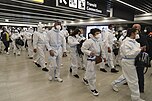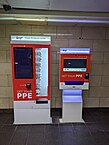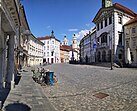COVID-19 pandemic in Pacitalia
| COVID-19 pandemic in Pacitalia | |
|---|---|
| Disease | COVID-19 |
| Virus strain | SARS-CoV-2 |
| Location | Pacitalia |
| First outbreak | Undisclosed |
| Index case | Sambuca |
| Arrival date | January 18, 2020 (4 years, 10 months and 6 days) |
| Confirmed cases | 14,631,202 (as of November 2024) |
| Suspected cases‡ | 560 million+ (see Testing) |
Deaths | 112,305 (as of November 2024) |
| Fatality rate | 0.77%
|
| Test positivity rate | 5.75% |
| Vaccinations |
|
| Government website | |
| gov | |
| ‡Suspected cases have not been confirmed by laboratory tests as being due to this strain, although some other strains may have been ruled out. | |
The COVID-19 pandemic in Pacitalia is part of the ongoing global pandemic of coronavirus disease 2019 (COVID-19). It is caused by severe acute respiratory syndrome coronavirus 2 (SARS-CoV-2). As of November 2024, all 22 autonomous communities in Pacitalia have recorded cases and deaths.
The virus was first detected in testing on January 18, 2020, from a Pacitalian citizen who had recently returned from international travel. The government declined to release information on which country or countries the traveller had visited. Following the detection of the index case, Pacitalia recorded its first official COVID-19-related death on February 6, 2020, when a woman in a nursing home died from complications related to the disease. The government introduced isolation and quarantine requirements on incoming international travel the following week, and, on February 22, mandated a lockdown in long-term care and assisted living facilities as severe illness and death rates began to climb.
Pacitalia was hit hard by the virus early on in the pandemic, despite measures taken to try to curb the initial spread of the virus. Authorities invoked a "global public health directive" under the Sanitation and Disease Act, and declared a state of emergency on February 28, 2020, with an initial two-week lockdown. Curfews and restrictions on gathering, transiting, and working in offices were implemented. Pacitalia closed its borders to all incoming travellers on March 4. On March 31, a mask mandate was introduced. Through most of March, Pacitalia was averaging 40,000 confirmed new COVID-19 cases per day. By April 5, "Black Sunday" marked a double milestone for the country during the pandemic, reaching one million confirmed cases and 50,000 deaths – a faster spread than other countries were experiencing.
Case counts began to decrease in late April, leading authorities to relax some lockdown measures. But cases began to increase again by May and public health experts labelled it the beginning of a "second wave". The government was forced to implement what Prime Minister Damián Moya called a "circuit breaker" lockdown in select urban areas, which was ultimately unsuccessful. A second nationwide lockdown then went into effect on May 16, 2020, lasting for three weeks. It was then partially rescinded and only applied to urban areas for an additional two months. This brought case counts under 1,000 per day and allowed the government to lift all measures – except for the mask mandate, social distancing guidelines, and the border closure – by August 1, 2020.
The country continued to experience "waves" of disease through the remainder of 2020. The virus also began to mutate as it spread through the population, and Pacitalia was the origin country of two variants of concern, P.4.5.2 and A.1.9, first identified in testing on October 23 and November 9, respectively. Epidemiologists raised alarm due to the increased transmissibility of the variant compared to the original form of the virus, as testing detected large-scale changes to the virus' spike proteins, raising fears the virus could begin to evade immunity and any eventual vaccines would be ineffective. A.1.9 eventually became the dominant variant of SARS-CoV-2 detected in testing by mid-December 2020.
Pacitalia surpassed five million confirmed cases on December 17, 2020, though experts warned that, even with widespread access to free, "gold standard" PCR testing, the majority of cases were still not being detected. Authorities continued to apply full or partial lockdown measures through early 2021 as a result. The government also ramped up funding for vaccination and treatment research, and by early spring, vaccine candidates were announced and nearly ready for mass use. Vaccines from Pacitalian pharmaceutical company Advanced Bionetics, and a joint effort by Pacitalian and Sarzonian pharmaceutical companies and university researchers, both using mRNA technology, were approved in late March 2021[1][2], just as Pacitalia registered 100,000 confirmed deaths.
Mass vaccination began on April 1, 2021[3], with a tightly controlled rollout that initially targeted high-risk individuals and people working in specific industry sectors. Coincident with administration of second doses, case counts plummeted to their lowest levels since the beginning of the pandemic. Due to a combination of mandatory vaccination, widespread public trust in the vaccines, and public eagerness to return to "normal" life, 96 percent of Pacitalians had received at least a first dose by early June[4]. Pacitalia reached 500 million doses by the end of that month, and nearly 99 percent uptake of required doses by the end of July (a span of just three months).
Pacitalia lifted its state of emergency on July 4, 2021[5], though it continued to treat COVID-19 as a "public health subject of concern".
The post-vaccination landscape in Pacitalia largely resembled pre-pandemic life, though international borders did not fully reopen until early 2022[6]. Case counts continued to fluctuate into 2023, though, thanks to vaccination and other treatments, incidences of severe illness and death are significantly lower than in the first few months of the pandemic. The pandemic resulted in massive economic impacts to Pacitalia, initially causing a recession and a spike in the unemployment rate to nearly 20 percent by mid-April 2020. Restrictions also forced the government to deploy an unprecedented expansion of public benefit programs, supports for small businesses and key industry sectors, and tax relief programs. The government's initial pandemic response, and coordination of public and private sector interests, has informed future pandemic preparations.
Background and epidemiology
Preparations
Variants of concern
Testing
Vaccination

Government response
Similar to other countries, the national government was initially scrambling to react to what was then a largely unknown pathogen demonstrating exponential spread and wide variability in the severity of disease. The Moya government was criticized early on for taking upwards of a month to enact the strictest measures, a delay many experts believe contributed to high rates of death and severe illness in the first few months of the pandemic. However, by summer 2020, restrictions and other public health measures helped reduce case counts and deaths, and government was able to deploy public resources to manage the ongoing pandemic response. Largely positive public perceptions of the government's pandemic response were seen as the primary reason Moya's Pacitalian Social Democratic Congress won a landslide victory in the November 2020 national elections.
Public health response
Social programs
Economic policies
Foreign relations
Misinformation
Political opposition to restrictions
Statistics
References
- ↑ "Pacitalia approves two vaccines for mass use", PBC News, March 29, 2021 – https://forum.nationstates.net/viewtopic.php?p=38501695#p38501695
- ↑ "Pacitalia approves vaccines for mass distribution", Woodstock Daily Mail, March 29, 2021 – https://forum.nationstates.net/viewtopic.php?p=38508238#p38508238
- ↑ "Government releases its full vaccination plan", PBC News, April 4, 2021 – https://forum.nationstates.net/viewtopic.php?p=38518613#p38518613
- ↑ "Government announces its plan to return to normal", PBC News, June 4, 2021 – https://forum.nationstates.net/viewtopic.php?p=38711737#p38711737
- ↑ "Official statement from the Archonate", Government of Pacitalia, July 3, 2021 – https://forum.nationstates.net/viewtopic.php?p=38791643#p38791643
- ↑ "COVID-19 travel advisory", Directorate of International Relations and Global Affairs, February 3, 2022 – https://forum.nationstates.net/viewtopic.php?p=39335601#p39335601





